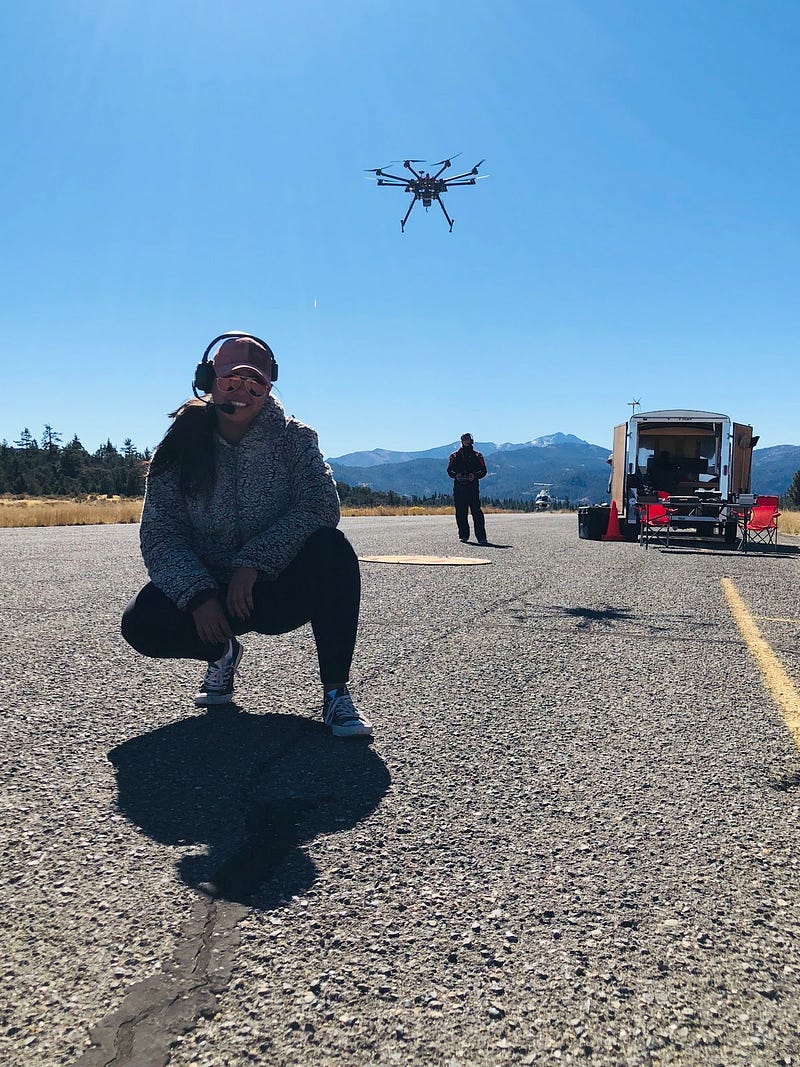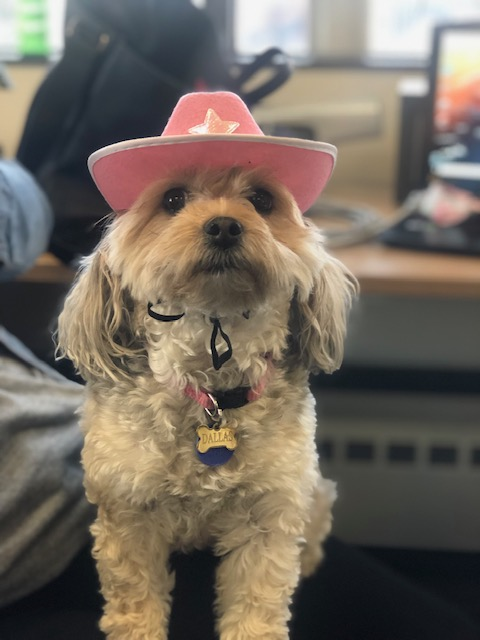Cheryl Contreras gives us a look into a typical day of field testing as the Deputy Head of Flight Operations at Iris Automation

I’ve worked at Iris for a year and a half, starting as a Flight Operations Technician and moving into a role as Deputy Head of Flight Operations. To give a little insight into what that means, here’s an account of a Field Test mission that’s a pretty typical example of my summertime routine. — Cheryl
4:15am Wake up and go to the gym. It’s still dark out, but I enjoy how quiet the gym is, and going before work gives me energy for the rest of the day.
5:15am Get back home and prepare for work, putting on clothes that help beat the heat. My favorite part of being Deputy Head of Flight Ops is planning — I’m a huge planner in every aspect of my life; I like structure. So actual mission planning and working towards a goal is what I enjoy. I also like being on communications with our manned aircraft and instructing flight paths while on the ground. I used to attend comms classes at the Reno Squadron Civil Air Patrol (CAP), where I’m a Senior member, but I haven’t been there in awhile due to how busy we are.
6:00am Leave the house and drive to work. Reno’s been growing steadily, especially with new tech startups, but the streets are still calm this early.
6:20am Arrive at the Innevation Center, a coworking space hosted by the University of Nevada-Reno. We started with a small corner, but the Iris Reno team now takes up most of the third floor.
6:30am Meet with my flight team for the day, Alex, Jason, and Greg. I’ve worked with Alex for over a year now. Jason joined late last year and Greg a few months back. But doing work like this you get to know each pretty fast.
We begin by packing our standard protocol gear: aircraft, batteries, ground control stations, cords, headsets, radio controllers, and checklists, and then load everything into the company Toyota Highlander and company trailer. We hook the trailer up and prepare for departure to our test site in Hazen, Nevada, approximately 45 minutes away.
6:50am We all grab a coffee on the second floor of the Innevation Center, a necessary part of our mission routine.

Then Alex, Jason, Greg, and Ryan (our manned aircraft pilot) all meet in the parking lot of the Innevation Center, near the Highlander, and conduct the mission brief I put together. The brief includes safety information, weather details, each person’s responsibility for the day, go/no go criteriasuch as weather/material issues/ intruders(ground or air), as well as a plethora of other items.
For today’s mission, I’ll be mission commander and leading the whole crew. Alex will be the Ground control station / mission planner, operating out of the trailer. Jason will be the Remote Pilot in Control, flying all unmanned aircrafts (drones) for the day. Greg will be the Visual Observer, monitoring for external factors such as weather, other aircraft, and generally making sure the area is safe. Finally, Ryan will be the manned pilot in the plane we’re testing our software against, collecting data and testing the system’s ability to detect, classify, and take avoidance maneuvers.
7:00am Depart for Hazen. I usually drive the company vehicle when I’m on a mission.

8:00am We arrive and unpack. I oversee ground control setup, aircraft, ensure pre-flight is completed, set up tables, battery chargers, generator, set up fire extinguishers where needed, and set up the canopy. Inside the trailer is the GCS (Ground Control Station) is setup (telemetry, etc. is ready to go).
Hazen is all desert and usually in the 90’s to 100’s during the summer, dropping down to freezing conditions in the winter. My favorite part of testing is being out in the field; I like being outdoors. Alpine is my favorite Test Site (Alpine County, CA-about an hour and a half south of Reno). Super beautiful in the summer-even saw a Bald eagle while testing last summer, I loved it.

Ryan contacts me when he has picked up the aircraft and is ready to fly out from KRNO. Today he’s flying a C-172; after take off we can expect him to arrive in 20–30 minutes.
8:30am First launch of our S900/S1000 drone airframes, aka Ernesto and Ursula. Ryan checks in with the Iris ground station, which sounds like this (I refer to him by the tail number of his aircraft; today it’s 446):
Me (Iris Ground): “446 — Please check-in”
Ryan (C-172): “40 gallons, 1 soul on board”
Me: “446 — Please loiter north, launching S900”
*S900 Launches*
Me: “446 — Ops normal We will commence flight path 1 along the railroad.”
Me: “446 — Ready for your first approach”
*Conduct flight testing*
Me: “446 — we are going to land S900 now, please loiter north”
Me: “446 — S900, safe on deck”
At this time the team and I will swap out batteries and do everything all over again with a different flight path. Flight paths include every cardinal direction — Meeting situations (head on), tangos (T form) or Yankees (Y Form) from North, South, East and West.
Me: “446 — Proceed with flight set 2” (All flight sets have been previously determined and all teammates on the mission made aware during the pre-flight brief.)
12:00pm I determine if adequate data is collected, and it is!
Me: “446 — Give me your check out procedures”
Ryan: “10 gallons of fuel, 1 soul on board.”
Ryan will now return the aircraft to KRNO while the ground crew and I pack out.
We begin to download data from the aircraft to an SSD card, which takes 30 minutes to 1 hour. Meanwhile, we pack up the tables, canopy, antenna mast/telemetry, landing pad, radio controllers, batteries, battery chargers, fire extinguishers, and generator.
12:45pm We depart Hazen and head back to the Innevation Center feeling accomplished.
1:00pm Pit stop for gas and snacks from small gas station in Fernley. My favorite snack of all time is lime hot Cheetos — a must have after a day of flying.
1:45pm Arrive at Innevation Center, park trailer, unhook from Highlander, start unpacking, start uploading data to the Iris DMS (data management system), and entering flight logs.

2:30pm Start charging the batteries for the next fly day and continue snacking!
3:00pm Create schedule of events for the next day, attend meetings, and catch up on emails and Slack, while also planning/preparing for deployments (demo, IPPs, customers).
5:00pm Make sure everything is ready for the next fly day. We typically conduct field tests 2–3 days in the week, with the other days more of a regular 9–5.
6:00pm Go home!
6:30pm I let my dog Dallas out (though sometimes she comes to work with me!), and work on my house that is currently being renovated by my boyfriend Stevie and I. We’ve completely gutted it and have a complete new bath, kitchen, and flooring. It has a wood burning stove and an accent brick wall that ties into our ‘Ranch Style’ home.

7:00pm Help Stevie feed our 6 horses, 2 goats and water the garden. We live on about two acres of land, with our living area separate from the animal and work area where Stevie runs his construction business and stores big equipment. We inherited the animals from his dad and he loves the baby horses. They’re cute so I can’t complain much.
7:45pm Begin cooking dinner. Today I’m making Peruvian Lomo Saltado. Some of my other staples include Aji de Gallina, Seco, Papa a la Huanciana, and Chicken Fried Steak with mashed potatoes. My dad is from Lima, Peru, and my mom is from Bakersfield, CA, so my cooking is only Peruvian or Southern with nothing in between at this time.
8:20pm Eat dinner, hang out with Stevie and Dallas, relax, pay bills, and organize. Lately I’ve started studying for the GRE. I haven’t decided what I want to Master in yet, maybe Information Systems, but I want to work on getting a high score for the time being.
10:30pm Go to bed!
